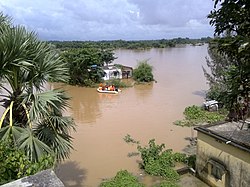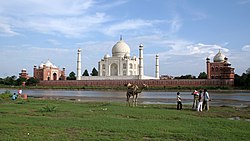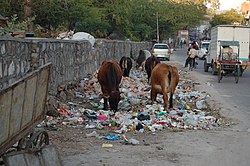From Wikipedia, the free encyclopedia
A satellite picture, taken in 2004, shows thick haze and smog along the Ganges Basin in northern
India.
Major sources of aerosols in this area are believed to be smoke from
biomass burning in the northwest part of India, and air pollution from
large cities in northern India since the 1980s. Dust from deserts in
Pakistan and the Middle East may also contribute to the mix of aerosols.
There are many environmental issues in India. Air pollution, water pollution,
garbage, domestically prohibited goods and pollution of the natural
environment are all challenges for India. Nature is also causing some
drastic effects on India. The situation was worse between 1947 through
1995. According to data collected and environmental assessments studied
by World Bank experts, between 1995 through 2010, India has made some of the fastest progress in addressing its environmental issues and improving its environmental quality in the world.
Still, India has a long way to go to reach environmental quality
similar to those enjoyed in developed economies. Pollution remains a
major challenge and opportunity for India.
Environmental issues are one of the primary causes of disease, health issues and long term livelihood impact for India.
Law and policies
British rule of India saw several laws related to the environment.
Amongst the earliest ones were Shore Nuisance (Bombay and Kolkata) Act
of 1853 and the Oriental Gas Company Act of 1857. The Indian Penal Code
of 1860, imposed a fine on anyone who voluntarily fouls the water of any
public spring or reservoir. In addition, the Code penalised negligent
acts. British India also enacted laws aimed at controlling air
pollution. Prominent amongst these were the Bengal Smoke Nuisance Act of
1905 and the Bombay Smoke Nuisance Act of 1912. Whilst these laws
failed in having the intended effect, British-enacted legislations
pioneered the growth of environmental regulations in India.
Upon independence from Britain, India adopted a constitution and
numerous British-enacted laws, without any specific constitutional
provision on protecting the environment. India amended its constitution
in 1976. Article 48(A) of Part IV of the amended constitution, read: The
State shall endeavour to protect and improve the environment and to
safeguard the forests and wildlife of the country. Article 51 A (g)
imposed additional environmental mandates on the Indian state.
Other Indian laws from recent history include the Water
(Prevention and Control of Pollution) Act of 1974, the Forest
(Conservation) Act of 1980, and the Air (Prevention and Control of
Pollution) Act of 1981. The Air Act was inspired by the decisions made
at Stockholm Conference. The Bhopal gas tragedy
triggered the Government of India to enact the Environment (Protection)
Act of 1986. India has also enacted a set of Noise Pollution
(Regulation & Control) Rules in 2000.
In 1985, the Indian government created the Ministry of Environment and Forests. This ministry is the central administrative organisation in India for regulating and ensuring environmental protection.
Despite the active passage of laws by the central government of
India, the reality of environmental quality mostly worsened between 1947
and 1990. Rural poor had no choice, but to sustain life in whatever way
possible. Air emissions increased, water pollution worsened, forest
cover decreased.
Starting in the 1990s, reforms were introduced. Since then, for
the first time in Indian history, major air pollutant concentrations
have dropped in every 5-year period. Between 1992 and 2010, satellite
data confirms India's forest coverage has increased for the first time
by over 4 million hectares, a 7% increase. In August 2019, the Indian government imposed a nationwide ban on single-use plastics that will take effect on 2 Oct.
Possible causes
Some have cited economic development
as the cause regarding the environmental issues. It is suggested that
India's growing population is the primary cause of India's environmental
degradation. Empirical evidence
from countries such as Japan, England and Singapore, each with
population density similar to or higher than that of India, yet each
enjoying environmental quality vastly superior to India's, suggests
population density may not be the only factor affecting India's issues.
Major issues
Floods
are a significant environmental issue for India. It causes soil
erosion, destruction of wetlands and wide migration of solid wastes.
Development of carbon dioxide emissions
Major environmental issues are forests and agricultural degradation of land, resource depletion (such as water, mineral, forest, sand, and rocks), environmental degradation, public health, loss of biodiversity, loss of resilience in ecosystems, livelihood security for the poor.
The major sources of pollution in India include the rapid burning
of fuelwood and biomass such as dried waste from livestock as the
primary source of energy, lack of organised garbage and waste removal
services, lack of sewage treatment operations, lack of flood control and
monsoon water drainage system, diversion of consumer waste into rivers,
using large land area for burial purposes, cremation practices near
major rivers, government mandated protection of highly polluting old
public transport, and continued operation by Indian government of
government-owned, high emission plants built between 1950 and 1980.
Air pollution, poor management of waste, growing water scarcity, falling groundwater tables, water pollution, preservation and quality of forests, biodiversity loss, and land/soil degradation are some of the major environmental issues India faces today.
India's population growth adds pressure to environmental issues
and its resources. Rapid urbanization has caused a buildup of heavy
metals in the soil of the city of Ghaziabad,
and these metals are being ingested through contaminated vegetables.
Heavy metals are hazardous to people's health and are known carcinogens.
Population growth and environmental quality
Public dumping of garbage alongside a road in
Kolkata.
There is a long history of study and debate about the interactions
between population growth and the environment. According to a British
thinker Malthus,
for example, a growing population exerts pressure on agricultural land,
causing environmental degradation, and forcing the cultivation of land
of higher as well as poorer quality. This environmental degradation
ultimately reduces agricultural yields and food availability, famines
and diseases and death, thereby reducing the rate of population growth.
Population growth, because it can place increased pressure on the
assimilative capacity of the environment, is also seen as a major cause
of air, water, and solid-waste pollution. The result, Malthus
theorised, is an equilibrium population that enjoys low levels of both
income and Environmental quality. Malthus suggested positive and
preventative forced control of human population, along with abolition of
poor laws.
Malthus theory, published between 1798 and 1826, has been analysed and criticised ever since. The American thinker Henry George,
for example, observed with his characteristic piquancy in dismissing
Malthus: "Both the jayhawk and the man eat chickens; but the more
jayhawks, the fewer chickens, while the more men, the more chickens."
Similarly, the American economist Julian Lincoln Simon criticised Malthus's theory. He noted that the facts of human history have proven the predictions of Malthus and of the Neo-Malthusians to be flawed. Massive geometric population growth in the 20th century did not result in a Malthusian catastrophe.
The possible reasons include: increase in human knowledge, rapid
increases in productivity, innovation and application of knowledge,
general improvements in farming methods (industrial agriculture), mechanisation of work (tractors), the introduction of high-yield varieties of rice and wheat among other plants (Green Revolution), the use of pesticides to control crop pests.
More recent scholarly articles concede that whilst there is no
question that population growth may contribute to environmental
degradation, its effects can be modified by economic growth and modern
technology. Research in environmental economics
has uncovered a relationship between environmental quality, measured by
ambient concentrations of air pollutants and per capita income. This
so-called environmental Kuznets curve
shows environmental quality worsening up until about $5,000 of per
capita income on purchasing parity basis, and improving thereafter.
The key requirement, for this to be true, is continued adoption of
technology and scientific management of resources, continued increases
in productivity in every economic sector, entrepreneurial innovation and
economic expansion.
Other data suggest that population density
has little correlation to environmental quality and human quality of
life. India's population density, in 2011, was about 368 human beings
per square kilometre. Many countries with population density similar or
higher than India enjoy environmental quality as well as human quality
of life far superior than India. For example: Singapore (7148 /km2), Hong Kong (6349 /km2), South Korea (487 /km2), Netherlands (403 /km2), Belgium (355 / km2), England (395 /km2) and Japan (337/ km2).
Water pollution
India has major water pollution
issues. Discharge of untreated sewage is an important cause for
pollution of surface and ground water in India, since there is a large
gap between the generation and treatment of domestic waste water. The
problem is not only that India lacks sufficient treatment capacity but
also that the sewage treatment plants that exist do not operate and are
not maintained.
The majority of government-owned sewage treatment plants remain closed
most of the time due to improper design, poor maintenance, or lack of
reliable electricity supply, along with severe understaffing. The waste
water generated in these areas normally percolates in the soil or
evaporates. The uncollected waste accumulates in urban areas, causing
unhygienic conditions and releasing pollutants that reach to surface and
groundwater.
According to a World Health Organization study,
out of India's 3,119 towns and cities, just 209 had partial sewage
treatment facilities, and only 8 have full wastewater treatment
facilities (1992). Over 100 Indian cities dump untreated sewage directly into the Ganges River.
Investment is needed to bridge the gap between 29,000 million litre per
day of sewage India generates, and a treatment capacity of mere 6000
million litre per day.
Other sources of water pollution include agriculture runoff and
small scale factories along the rivers and lakes of India. Fertilizers
and pesticides used in agriculture in northwestern India have been found
in rivers, lakes and ground water.
Flooding during monsoons worsens India's water pollution problem, as it
washes and moves all sorts of solid garbage and contaminated soils into
its rivers and wetlands.
Water resources
According
to NASA groundwater declines are highest on Earth between 2002 and 2008
in northern India. Agricultural productivity is dependent on
irrigation. A collapse of agricultural output and severe shortages of
potable water may influence 114 million residents in India. In July
2012, about 670 million people or 10% of the world’s population lost
power blame on the severe drought restricting the power delivered by
hydroelectric dams.
Air pollution
A
rural stove using biomass cakes, fuelwood and trash as cooking fuel.
Surveys suggest over 100 million households in India use such stoves
(chullahs) every day, 2–3 times a day. It is a major source of
air pollution in India,
and produces smoke and numerous indoor air pollutants at concentrations
5 times higher than coal. Clean burning fuels and electricity are
unavailable in rural parts and small towns of India because of poor
rural highways and limited energy generation infrastructure.
Air pollution in India is a serious issue, with the major sources
being biomass burning, fuel adulteration, vehicle emission, and traffic
congestion. Air pollution is also the main cause of the Asian brown cloud, which has been causing the monsoon
season to be delayed. India is the world's largest consumer of
fuelwood, agricultural waste, and biomass for energy purposes.
Traditional fuel (fuelwood, crop residue and dung cake) dominates
domestic energy use in rural India and account for about 90% of the
total. In urban areas, traditional fuel constitutes about 24% of the
total. Fuel wood, agricultural waste and biomass cake burning release
over 165 million tonnes of combustion products every year.
These biomass-based household stoves in India are also a leading source
of greenhouse emissions, which contribute to climate change.
The annual crop burning practice in northwest India, north India and eastern Pakistan,
before and after monsoons, from April and May to October to November,
are a major seasonal source of air pollution since the 1980s.
Approximately 500 million tons of crop residue are burnt in the open,
releasing NOx, SOx, PAHs and particulate matter into the air. This
burning has been found to be a leading cause of smog and haze problems
through the winter over Punjab, cities such as Delhi, and major
population centers along the rivers through West Bengal. In other states of India, rice straw and other crop residue burning in open is a major source of air pollution.
Vehicle emissions are another source of air pollution. Vehicle
emissions are worsened by fuel adulteration and poor fuel combustion
efficiencies from traffic congestion and low density of quality, high
speed road network per 1000 people.
In order to reduce air pollution effects India is introducing hybrid
and electric vehicles as per the Faster Adoption and Manufacturing of
Electric vehicles in India scheme. While challenges are slowing down the
development cleaner combustion fuels are being use in motor vehicles.
As of now Delhi Transport Corporation
is the world's largest operator of CNG bus fleet. Many Indian cities
are testing out with cleaner fossil fuels mostly CNG fuel and renewable
biofuels such as biodiesel and E85 blended petroleum. In June 2020, the
supreme court promised that in order to improve emissions from vehicles
all BS4 vehicles will be upgraded to BS6 standards.
On per capita basis, India is a small emitter of carbon dioxide
greenhouse. In 2009, IEA estimates that it emitted about 1.4 tons of gas
per person, in comparison to the United States’ 17 tons per person, and
a world average of 5.3 tons per person. However, India was the third
largest emitter of total carbon dioxide
in 2009 at 1.65 Gt per year, after China (6.9 Gt per year) and the
United States (5.2 Gt per year). With 17 percent of world population,
India contributed some 5 percent of human-sourced carbon dioxide emission; compared to China's 24 percent share.
The Air (Prevention and Control of Pollution) Act was passed in 1981 to regulate air pollution and there have been some measurable improvements. However, the 2012 Environmental Performance Index ranked India at 177th position out of 180 countries in 2018,as having the poorest relative air quality out of 132countries. Of the world's 30 most polluted cities, India is home to 21 as of 2020.
Solid waste pollution
Trash
and garbage disposal services, responsibility of local government
workers in India, are ineffective. Solid waste is routinely seen along
India's streets and shopping plazas. Image shows solid waste pollution
along a Jaipur street, a 2011 image.
Trash and garbage are a common sight in urban and rural areas of
India. It is a major source of pollution. Indian cities alone generate
more than 100 million tons of solid waste a year. Street corners are
piled with trash. Public places and sidewalks are despoiled with filth
and litter, rivers and canals act as garbage dumps. In part, India's
garbage crisis is from rising congestion. India's waste problem also
points to a stunning failure of governance. The tourism regions in the country mainly hill stations are also facing this issue in the recent years.
In 2000, India's Supreme Court directed all Indian cities to
implement a comprehensive waste-management programme that would include
household collection of segregated waste, recycling and composting.
These directions have simply been ignored. No major city runs a
comprehensive programme of the kind envisioned by the Supreme Court.
Indeed, forget waste segregation and recycling directive of the
India's Supreme Court, the Organisation for Economic Cooperation and
Development estimates that up to 40 percent of municipal waste in India
remains simply uncollected. Even medical waste,
theoretically controlled by stringent rules that require hospitals to
operate incinerators, is routinely dumped with regular municipal
garbage. A recent study found that about half of India's medical waste
is improperly disposed of.
Municipalities in Indian cities and towns have waste collection
employees. However, these are unionised government workers and their
work performance is neither measured nor monitored.
Some of the few solid waste landfills India has, near its major
cities, are overflowing and poorly managed. They have become significant
sources of greenhouse emissions and breeding sites for disease vectors
such as flies, mosquitoes, cockroaches, rats, and other pests.
Waste collection truck in Ahmedabad, Gujarat
In 2011, several Indian cities embarked on waste-to-energy projects of the type in use in Germany, Switzerland and Japan.
For example, New Delhi is implementing two incinerator projects aimed
at turning the city’s trash problem into electricity resource. These
plants are being welcomed for addressing the city’s chronic problems of
excess untreated waste and a shortage of electric power. They are also
being welcomed by those who seek to prevent water pollution, hygiene
problems, and eliminate rotting trash that produces potent greenhouse
gas methane. The projects are being opposed by waste collection workers
& local unions who fear changing technology may deprive them of
their livelihood and way of life.
Noise pollution
Noise pollution or noise disturbance is the most efficiently changing
and disturbing or excessive noise that may harm the activity or balance
of human or animal life. The source of most outdoor noise worldwide is
mainly caused by machines and transportation systems, motor vehicles,
aircraft, and trains. In India the outdoor noise is also caused by
loud music during festival seasons.Outdoor noise is summarized by the
word environmental noise. Poor urban planning may give rise to noise
pollution, since side-by-side industrial and residential buildings can
result in noise pollution in the residential areas.
Indoor noise can be caused by machines, building activities, and
music performances, especially in some workplaces. Noise-induced hearing
loss can be caused by outside (e.g. trains) or inside (e.g. music)
noise.
High noise levels can contribute to cardiovascular effects in humans and an increased incidence of coronary artery disease.
In animals, noise can increase the risk of death by altering predator
or prey detection and avoidance, interfere with reproduction and
navigation, and contribute to permanent hearing loss.
The Supreme Court of India which is in New Delhi gave a significant verdict on noise pollution in 2005. Unnecessary honking of vehicles makes for a high decibel level of noise in cities. The use of loudspeakers for political purposes and for sermons by temples and mosques makes noise pollution in residential areas worse.
In January 2010, Government of India published norms of permissible noise levels in urban and rural areas.
Erosion of sands
In March 2009, the issue of Punjab attracted press coverage. It was alleged to be caused by flying ash ponds of thermal power stations, which reportedly lead to severe birth defects in children in the Faridkot and Bhatinda districts of Punjab. The news reports claimed the uranium levels were more than 60 times the maximum safe limit. In 2012, the Government of India confirmed
that the ground water in Malwa belt of Punjab has uranium metal that is
50% above the trace limits set by the United Nations' World Health
Organization. Scientific studies, based on over 1000 samples from
various sampling points, could not trace the source to fly ash and any
sources from thermal power plants or industry as originally alleged. The
study also revealed that the uranium concentration in ground water of
Malwa district is not 60 times the WHO limits, but only 50% above the
WHO limit in 3 locations. This highest concentration found in samples
was less than those found naturally in ground waters currently used for
human purposes elsewhere, such as Finland. Research is underway to identify natural or other sources for the uranium.
Greenhouse gas emissions
India was the third largest emitter of carbon dioxide, a major greenhouse gas,
in 2009 at 1.65 Gt per year, after China and the United States . With
17 percent of world population, India contributed some 5 percent of
human-sourced carbon dioxide emission; compared to China's 24 percent
share. On per capita basis, India emitted about 1.4 tons of carbon
dioxide per person, in comparison to the United States’ 17 tons per
person, and a world average of 5.3 tons per person.
Forests
India had a 2018 Forest Landscape Integrity Index mean score of 7.09/10, ranking it 58th globally out of 172 countries.







































